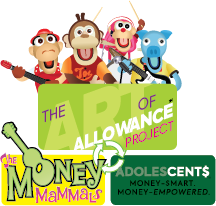
“Working to help parents raise money-smart kids.”
Hello, friends!
The dog days of summer are here, and things seem to be warming up at Snigglezoo as a result. (BTW, how do you like our new logo?)
I was already smoking with excitement after my speaking engagement at July’s CUFEN (Credit Union Financial Education Network) Conference, and this past week generated even more heat. 🔥
— 1 —
The Next Generation: My five-year-old nephew just started his allowance! 👏🏻 For me, this is the equivalent of his starting kindergarten. (Which he does this month too!) Here’s his setup:
Naturally, this reminds me of when my oldest began her allowance:
Besides taking me for a trip down memory lane, this new development excites me for two reasons. First, of course, he’s my nephew, and his parents are starting his allowance at an ideal time to ensure that he’ll learn the basic money smart skills. Case in point: He’s already saving for his first goal, a new LEGO set!
Second, his mom (my sister, Kelly) has a pretty major Instagram following. Her sharing the image below caused us to experience a nice engagement bump on that platform. (A big thank you to her for her support. 🙏🏻)
— 2 —
Ready for Launch: My sister excitedly explained that her favorite feature of my book, The Art of Allowance, was its brevity: “I finished half the book during one of Arlo’s naps!” However, I know that not every busy mom or dad has enough time for my treatise on allowance.
So I had our crackerjack team create The Allowance Launcher, which you can download right now. That’s right! You can kick-start your family’s money-smart journey in the time it takes to print a document.
You’re welcome! 😉
I also recorded a short video about this new favorite tool of mine:
Hopefully you will find it to be a helpful resource as you set out on the path to money empowerment.
— 3 —
You Can’t Afford Not to Start Early: Starting early matters, so much so that I included the following excerpt in The Art of Allowance. It’s one of my “Memos from the Chief Mammal” that I spatter throughout the book to underscore the value of using an intentional allowance as a tool to help your kids grow up money-smart.
You Can’t Afford Not to Start Early
We live in a consumer culture. When do you think kids are first exposed to media messages? Before they’re two years old—sometimes when they’re babies! Even the most progressive parents can have a difficult time keeping media out of the watchful eyes of their children. Omnipresent screens, billboards, magazines in doctors’ offices and also ads in schools heighten the challenge.
Research suggests you should teach kids to be wary of consumer products and spending from a very young age—early elementary or even preschool. (Please note that this instruction will not miraculously cure the “I want its” of a four-year-old. That would require actual magic dust.) By talking to your kids early about responsible money smarts, you expose them to messages that counter those about the consumption of stuff.
You may be familiar with the term “emergent literacy,” the concept that children are in the process of learning to read and write by absorbing knowledge when they are in early childhood, babies even. This notion is the reason many of us read to our children before they can walk.
It’s helpful to consider teaching money smarts and wariness of stuff to young kids as “early childhood financial literacy,” a term coined by David Godsted and Martha McCormick. Young children assimilate the ever-present messages about consumption and can readily absorb communications that counter the American creed to “consume more.” By not introducing the concepts and language of money—sharing, saving and spending smart—to our children at a young age, we do as much of a disservice to them as if we did not expose them early to books and writing.
I wish you the best on what I hope for you and your family is a long and fruitful journey. Of course, don’t forget to enjoy it.
Until next week!
John, Chief Mammal
P.S. Please consult with a financial or investment professional before engaging in any decisions that might affect your own financial well-being.
Sources:
- “Marketing to Children Overview.” Campaign for a Commercial-Free Childhood, June 19, 2017, http://www.commercialfreechildhood.org/resource/marketing-children-overview.
- Drever, Anita I., Elizabeth Odders-White, Charles W. Kalish, Nicole M. Else-Quest, Emily M. Hoagland, and Emory N. Nelms. “Foundations of Financial Well-Being: Insights into the Role of Executive Function, Financial Socialization, and Experience-Based Learning in Childhood and Youth.” The Journal of Consumer Affairs 49.1 (2015): 21-22. See also: Kulhmann, Eberhard. “On the Economic Analysis of the Information Seeking Behavior of Consumers.” Journal of Consumer Policy 6.2 (1983): 231-37.
- McCormick, Martha H. and David Godsted. “Learning Your Monetary ABCs: The Link between Emergent Literacy and Early Childhood Financial Literacy.” Networks Financial Institute at Indiana University, NFI Report, 2006: 1-14.
Like what you just read? You can sign up for the newsletter here.
